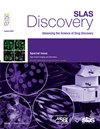磷酸核糖基甲酰基甘氨酸合成酶的高通量测定。
IF 2.7
4区 生物学
Q2 BIOCHEMICAL RESEARCH METHODS
引用次数: 0
摘要
嘌呤生物合成的代谢重编程是癌症代谢的一个标志,代表了一个关键的脆弱性。磷酸核糖基甲酰基甘氨酸合成酶(PFAS)催化嘌呤新生生物合成的第四步,并已被证明是肝癌生存的预后因素。尽管这种蛋白作为药物靶点很重要,但目前还没有已知的特异性PFAS活性抑制剂。在这里,我们描述了一种新的连续分光光度法测定PFAS合成酶结构域,适用于高通量筛选(HTS)。这种基于机制的荧光分析利用了酸性磷酸酶底物,6,8-二氟-4-甲基伞花酰磷酸(DiFMUP)。PFAS催化DiFMUP的周转,KM为108±7µM。在优化和小型化1536孔格式的分析后,我们使用LOPAC1280文库进行了试点HTS。该方法的检测效果非常好,平均Z´为0.94±0.02,平均信噪比为5.01±0.06,板间相关性良好,准确率为1.18%。该分析为推进PFAS酶学研究提供了一个急需的工具,并将为发现小分子抑制剂作为功能探针和新药开发的基础奠定基础。本文章由计算机程序翻译,如有差异,请以英文原文为准。
A high throughput assay for phosphoribosylformylglycinamidine synthase
Metabolic reprogramming of purine biosynthesis is a hallmark of cancer metabolism and represents a critical vulnerability. The enzyme phosphoribosylformylglycinamidine synthase (PFAS) catalyzes the fourth step in de novo purine biosynthesis and has been demonstrated to be prognostic for survival of liver cancer. Despite the importance of this protein as a drug target, there are no known specific inhibitors of PFAS activity. Here, we describe a new continuous, spectrophotometric assay for the synthase domain of PFAS that is amenable to high-throughput screening (HTS). This mechanism-based fluorescent assay makes use of the acid phosphatase substrate, 6,8-difluoro-4-methylumbelliferyl phosphate (DiFMUP). PFAS catalyzes the turnover of DiFMUP with a KM of 108 ± 7 µM. After optimization and miniaturization of the assay for 1,536-well format, we conducted a pilot HTS using the LOPAC1280 library. The assay performed extremely well, with an average Z′ of 0.94 ± 0.02, average signal to noise of 5.01 ± 0.06, excellent inter plate correlation, and a hit rate of 1.18 %. This assay provides a critically needed tool to advance the study of PFAS enzymology and will be foundational for the discovery of small molecule inhibitors both as functional probes and for the basis of new drug development.
求助全文
通过发布文献求助,成功后即可免费获取论文全文。
去求助
来源期刊

SLAS Discovery
Chemistry-Analytical Chemistry
CiteScore
7.00
自引率
3.20%
发文量
58
审稿时长
39 days
期刊介绍:
Advancing Life Sciences R&D: SLAS Discovery reports how scientists develop and utilize novel technologies and/or approaches to provide and characterize chemical and biological tools to understand and treat human disease.
SLAS Discovery is a peer-reviewed journal that publishes scientific reports that enable and improve target validation, evaluate current drug discovery technologies, provide novel research tools, and incorporate research approaches that enhance depth of knowledge and drug discovery success.
SLAS Discovery emphasizes scientific and technical advances in target identification/validation (including chemical probes, RNA silencing, gene editing technologies); biomarker discovery; assay development; virtual, medium- or high-throughput screening (biochemical and biological, biophysical, phenotypic, toxicological, ADME); lead generation/optimization; chemical biology; and informatics (data analysis, image analysis, statistics, bio- and chemo-informatics). Review articles on target biology, new paradigms in drug discovery and advances in drug discovery technologies.
SLAS Discovery is of particular interest to those involved in analytical chemistry, applied microbiology, automation, biochemistry, bioengineering, biomedical optics, biotechnology, bioinformatics, cell biology, DNA science and technology, genetics, information technology, medicinal chemistry, molecular biology, natural products chemistry, organic chemistry, pharmacology, spectroscopy, and toxicology.
SLAS Discovery is a member of the Committee on Publication Ethics (COPE) and was published previously (1996-2016) as the Journal of Biomolecular Screening (JBS).
 求助内容:
求助内容: 应助结果提醒方式:
应助结果提醒方式:


